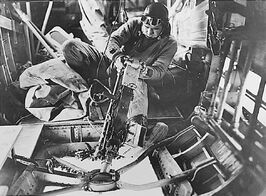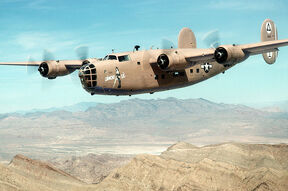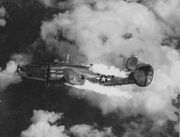The B-24 Liberator was a heavy bomber used by the United States and Allies during World War II.
Description[]
The B-24 was developed by Consolidated Aircraft as the model 32, and used four 1,000 hp Pratt and Whitney R-1830 Twin Wasp engines, giving it speeds of up to 487 km/h and a range of around 4,828 kilometers. It could hold a crew of 8-10 men, and was armed with a total of nine 12.7 mm machine guns.[1]
While the B-24 was produced in a greater quality and was generally used in more locations than its counterpart, the Boeing B-17 Flying Fortress, the B-17 provided a far more reliable platform as the B-24, utilizing large amounts of hydraulics rather than electronics, pushing the fuel to be kept in the wings and near the bomb bay. This meant that the B-24 could easily catch fire and generally had a lower surviveability rate.
Variants[]
The first variant consisted of seven YB-24 airframes for service evaluation. These differed from the XB-24 by having de-icing boots on the wings and tail assembly, gross weight of 21,046 kilograms, no wing slots and - initially - propeller spinners.[2] These were followed by the first twenty six Liberators from the initial production line at San Diego, which were flown to Great Britain as the B-24. These were also known by the LB-30A designation, used to describe Liberators built to British Specifications.[3] Due to their unsuitability for European Combat Conditions, they were converted into unarmed transport aircraft for use on the Trans-Atlantic Return Ferry Service.[3]
The next variant was the B-24A, also known as the Liberator I. This was armed with six 12.7mm and two 7.62mm machine guns.[N 1] These aircraft were followed by the Liberator II (LB-30),[N 2] powered by Pratt & Whitney R-1830-S3C4G engines with two speed superchargers, and armed with eleven 0.303 in machine guns - four in dorsal turret, four in tail turret, one in nose and two in waist positions.[3]
The designation XB-24B was applied to the first B-24 after it was fitted with refinements such as turbo superchargers and self-sealing fuel tanks.[3] This led to the B-24C, powered by Pratt & Whitney R-1830–41 engines with exhaust driven turbo superchargers.[3]

An early B-24 ventral turret
Next came the B-24D (PB4Y-1 and Liberator B.III/G.R.V), with R-1830-43 engines and armament increased to ten 12.7mm guns. Increased fuel supply due to auxiliary tanks in outer wings, which could be augmented by tanks in the bomb bay. First model equipped with two external bomb racks under the inner wings, each rated at 1,814 kilograms.[N 3] A similar aircraft with minor equipment changes was built at Fort Worth by Consolidated, Willow Run by Ford and Tulsa by Douglas as the B-24E (Liberator IV).[3] The B-24D was the first B-24 model to see proper mass production and was largely flown in combat operations against the Empire of Japan.
A single B-24E was experimentally fitted with exhaust heated anti icing equipment, flying as the B-24F.[3] Also similar except for equipment details and minor differences due to different methods of manufacture were the B-24G, B-24H and B-24J (PB4Y-1 and Liberator B.VI and G.R. VI). B-24G built at Dallas by North American Aviation. B-24H built at Fort Worth by Consolidated, Willow Run by Ford and Tulsa by Douglas. B-24J built at San Diego and Fort Worth by Consolidated and Dallas by Ford, Douglas and North American Aviation.[3] A single B-24J was fitted with the nose section of a B-17G[4] A number of B-24s were fitted with cameras for photo-reconnaissance duties, consisting of B-24Hs with eleven cameras as the F-7-FO, eighty-six B-24Js with three cameras in the nose and three in the bomb bay as F-7As, and other B-24Js with six cameras in the bomb bay as F-7Bs.[5]
The first version to replace the twin endplates with a single tail fin was the single experimental XB-24K,[3] which was produced in 1943 by converting a B-24D-40-CO (serial number 42-40234).[6]
Next came the B-24L, which was basically an amended B-24J with new tail turret with two manually operated 12.7mm guns with a wider field of fire. The new turret was designed by the Consolidated Vultee Modification Centre at Tucson, and permitted a weight saving of 91 kg.[3] A sub variant of the B-24L with power operated tail turret built by Motor Products was designated B-24M. The last B-24 of 6,725th built by Consolidated Vultee at San Diego was a B-24M.[3]

A B-24A flies in an air show
A limited number of production single tail B-24 aircraft were built as the B-24N, before B-24 production ended on May 31, 1945.[3] B-24 aircraft withdrawn from operational use in European Theatre of Operations (ETO) were designated CB-24. These aircraft had their armament removed and adapted for use as transport aircraft and Group Identity Aircraft (Assembly ships) to ensure the easy assembly of bomber formations. Aircraft used for assembly duty received bright colour schemes.[3] (Some of these aircraft also had banks of lights fitted in the gun positions).
A number of captured examples were repaired and flown by the Luftwaffe.
History[]
In January 1939 General Arnold invited Consolidated to prepare a design study for a bomber which had greater performance that the B-17 Flying Fortress, which led to a formal specification demanding a maximum speed of at least 300 mph, range of 3,000 miles and ceiling of 35,000 ft. The contract for construction of the first Model 32 was signed on March 30, 1939, with the prototype XB-24, registered 39-680 flying nine months later on December 29, 1939, one day under the nine months stipulated in the contract, with an initial gross weight of 41,000 lbs.[7] Production for US, British and French governments began in the Autumn of 1940. British authorities took over the French contracts after the fall of France, with early production aircraft being mainly delivered under British contracts.[3]

A B-24 hit by flak during a combat sortie (Note how prevalent it was for the type to catch fire)
The RAF began accepting these shipments of B-24s following the Fall of France though without many of the key features that it would later have, such as self-sealing fuel tanks, most models were rejected and put into secondary roles. When the improvements were added, the B-24s began to play a more pivotal role in the war. Seeing service in all theaters, such as Burma, the Eastern Front, the Western Front, etc. From then on, the B-24 became a staple bomber, being especially critical in the air war over Germany. In total, around 18,000 examples had been produced during the war.
Notes[]
- ↑ Examples with RAF Coastal Command were fitted with four 20 mm cannon in a belly pack, two 0.303 in guns in the waist, one 0.303in gun in a rear tunnel and two 0.303 in guns in the tail.[3]
- ↑ No B-24 counterpart.[3]
- ↑ G.R.V aircraft with RAF Coastal Command used as long range reconnaissance aircraft, with one 0.303 in or 0.5 in gun in the nose, two 0.5 in guns in the upper turret, four 0.303 in or two 0.5 in guns in waist positions and four 0.3.3 in guns in a Boulton Paul tail turret, plus bomb/depth charge load of 5,400 lbs.[3]
References[]
- ↑ http://www.wwiivehicles.com/usa/aircraft/bomber/consolidated-b-24-liberator.asp
- ↑ Green, William. Famous Bombers of the Second World War. Purnell Book Services. 1975. Page 166.
- ↑ 3.00 3.01 3.02 3.03 3.04 3.05 3.06 3.07 3.08 3.09 3.10 3.11 3.12 3.13 3.14 3.15 3.16 Gunston, Bill (Forward). Jane's Fighting Aircraft of World War II. Tiger Books. 1989. ISBN 1-85501-996-5. (Reprint of Jane's All The World's Aircraft 1945/1946. Bridgeman, Leonard (Editor). 1946). Page 215.
- ↑ Green, William - Bombers. Page 175.
- ↑ Green, William - Bombers. Page 179.
- ↑ Green, William - Bombers. Page 177.
- ↑ Green, William - Bombers. Page 165.
| |||||||||||||||||||||||
